英语论文——英语谚语中的比喻修辞
- 格式:doc
- 大小:135.00 KB
- 文档页数:23
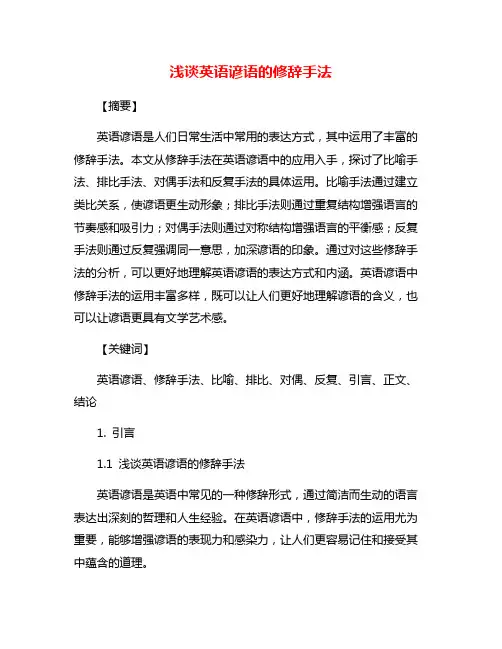
浅谈英语谚语的修辞手法【摘要】英语谚语是人们日常生活中常用的表达方式,其中运用了丰富的修辞手法。
本文从修辞手法在英语谚语中的应用入手,探讨了比喻手法、排比手法、对偶手法和反复手法的具体运用。
比喻手法通过建立类比关系,使谚语更生动形象;排比手法则通过重复结构增强语言的节奏感和吸引力;对偶手法则通过对称结构增强语言的平衡感;反复手法则通过反复强调同一意思,加深谚语的印象。
通过对这些修辞手法的分析,可以更好地理解英语谚语的表达方式和内涵。
英语谚语中修辞手法的运用丰富多样,既可以让人们更好地理解谚语的含义,也可以让谚语更具有文学艺术感。
【关键词】英语谚语、修辞手法、比喻、排比、对偶、反复、引言、正文、结论1. 引言1.1 浅谈英语谚语的修辞手法英语谚语是英语中常见的一种修辞形式,通过简洁而生动的语言表达出深刻的哲理和人生经验。
在英语谚语中,修辞手法的运用尤为重要,能够增强谚语的表现力和感染力,让人们更容易记住和接受其中蕴含的道理。
修辞手法在英语谚语中的运用可以说是无处不在。
比如常见的比喻手法,通过对不同事物之间的相似进行对比,凸显谚语的含义和意义;排比手法则是通过重复使用相同的语法结构,使谚语更加生动和有节奏感;对偶手法则是通过对称的结构和相反的词语来呈现谚语的内容,让人印象深刻;反复手法则是通过反复使用相同的词语或短语来强调谚语的重点,使人们更容易理解和记忆。
通过对英语谚语中修辞手法的分析和研究,我们可以更好地理解和欣赏这些古老的智慧之言。
在接下来的内容中,我们将深入探讨比喻手法、排比手法、对偶手法和反复手法在英语谚语中的应用,从而更好地总结英语谚语的修辞手法。
2. 正文2.1 修辞手法在英语谚语中的应用修辞手法在英语谚语中的应用是非常丰富多样的,通过巧妙运用各种修辞手法,谚语能够更生动、形象地表达出其中所包含的哲理和智慧。
修辞手法在英语谚语中的运用可以分为比喻手法、排比手法、对偶手法和反复手法等几种,每种手法都能够为谚语增添一种独特的修辞效果。
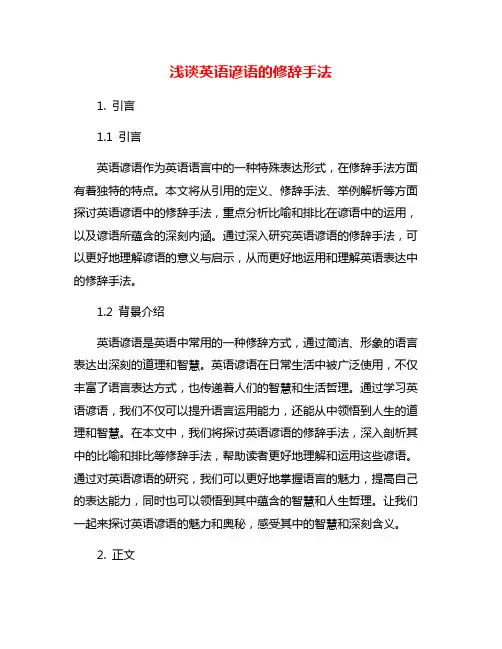
浅谈英语谚语的修辞手法1. 引言1.1 引言英语谚语作为英语语言中的一种特殊表达形式,在修辞手法方面有着独特的特点。
本文将从引用的定义、修辞手法、举例解析等方面探讨英语谚语中的修辞手法,重点分析比喻和排比在谚语中的运用,以及谚语所蕴含的深刻内涵。
通过深入研究英语谚语的修辞手法,可以更好地理解谚语的意义与启示,从而更好地运用和理解英语表达中的修辞手法。
1.2 背景介绍英语谚语是英语中常用的一种修辞方式,通过简洁、形象的语言表达出深刻的道理和智慧。
英语谚语在日常生活中被广泛使用,不仅丰富了语言表达方式,也传递着人们的智慧和生活哲理。
通过学习英语谚语,我们不仅可以提升语言运用能力,还能从中领悟到人生的道理和智慧。
在本文中,我们将探讨英语谚语的修辞手法,深入剖析其中的比喻和排比等修辞手法,帮助读者更好地理解和运用这些谚语。
通过对英语谚语的研究,我们可以更好地掌握语言的魅力,提高自己的表达能力,同时也可以领悟到其中蕴含的智慧和人生哲理。
让我们一起来探讨英语谚语的魅力和奥秘,感受其中的智慧和深刻含义。
2. 正文2.1 引用的定义"引用"是修辞手法中的一种,指的是在文章中引用他人的观点或言论来支持自己的论点。
通过引用他人的话语,可以增加文章的权威性和可信度,同时也能够更有说服力地表达自己的观点。
引用通常需要注明出处,以示尊重原作者的版权权益。
在英语谚语中,引用的形式多样,可能是直接引用他人的话语,也可能是借用某个故事或典故来阐述一个道理。
通过引用,可以使谚语更具深度和内涵,让人们更容易理解其中所包含的道理和智慧,同时也能够让谚语更加生动有趣。
在修辞学中,引用的运用需要注意引用的时机和方式,不能过多地依赖他人的观点而失去自己的独立思考,同时也要确保引用的内容和自己的论点相互协调,避免出现矛盾和不连贯的情况。
引用的灵活运用可以使文章更富有表现力和感染力,让读者更容易被文章所吸引。
2.2 修辞手法修辞手法是修辞学的重要内容之一,是指在语言表达中为了增强感染力、形象力和说服力而采用的一种技巧性手段。
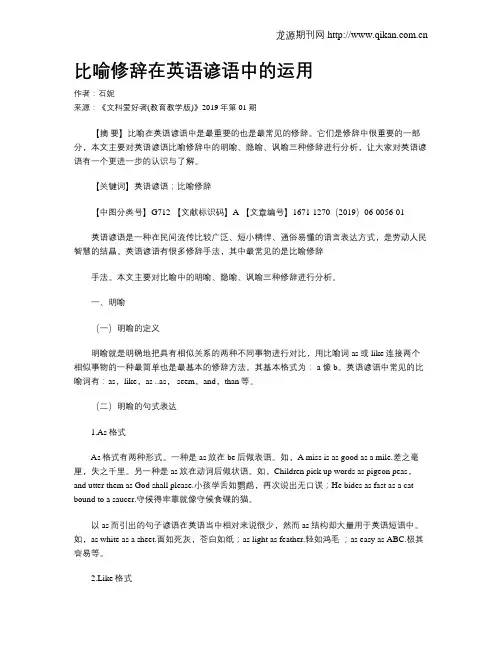
比喻修辞在英语谚语中的运用作者:石妮来源:《文科爱好者(教育教学版)》2019年第01期【摘要】比喻在英语谚语中是最重要的也是最常见的修辞。
它们是修辞中很重要的一部分,本文主要对英语谚语比喻修辞中的明喻、隐喻、讽喻三种修辞进行分析,让大家对英语谚语有一个更进一步的认识与了解。
【关键词】英语谚语;比喻修辞【中图分类号】G712 【文献标识码】A 【文章编号】1671-1270(2019)06-0056-01英语谚语是一种在民间流传比较广泛、短小精悍、通俗易懂的语言表达方式,是劳动人民智慧的结晶。
英语谚语有很多修辞手法,其中最常见的是比喻修辞手法。
本文主要对比喻中的明喻、隐喻、讽喻三种修辞进行分析。
一、明喻(一)明喻的定义明喻就是明确地把具有相似关系的两种不同事物进行对比,用比喻词as或like连接两个相似事物的一种最简单也是最基本的修辞方法。
其基本格式为: a像b。
英语谚语中常见的比喻词有:as,like,as ..as, seem,and,than等。
(二)明喻的句式表达1.As格式As格式有两种形式。
一种是as放在be后做表语。
如,A miss is as good as a mile.差之毫厘,失之千里。
另一种是as放在动词后做状语。
如,Children pick up words as pigeon peas,and utter them as God shall please.小孩学舌如鹦鹉,再次说出无口误;He bides as fast as a cat bound to a saucer.守候得牢靠就像守候食碟的猫。
以as而引出的句子谚语在英语当中相对来说很少,然而as结构却大量用于英语短语中。
如,as white as a sheet.面如死灰,苍白如纸;as light as feather.轻如鸿毛;as easy as ABC.极其容易等。
2.Like格式由like引出的明喻可以放在系动词之后或行为动词之后,它在句中放在系动词后来做表语。
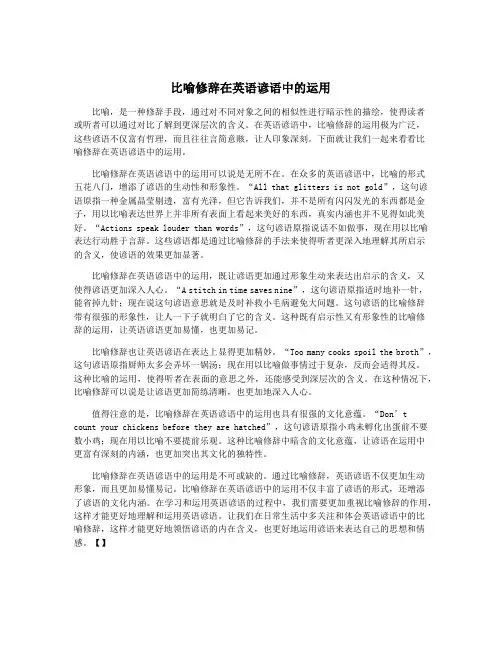
比喻修辞在英语谚语中的运用比喻,是一种修辞手段,通过对不同对象之间的相似性进行暗示性的描绘,使得读者或听者可以通过对比了解到更深层次的含义。
在英语谚语中,比喻修辞的运用极为广泛,这些谚语不仅富有哲理,而且往往言简意赅,让人印象深刻。
下面就让我们一起来看看比喻修辞在英语谚语中的运用。
比喻修辞在英语谚语中的运用可以说是无所不在。
在众多的英语谚语中,比喻的形式五花八门,增添了谚语的生动性和形象性。
“All that glitters is not gold”,这句谚语原指一种金属晶莹剔透,富有光泽,但它告诉我们,并不是所有闪闪发光的东西都是金子,用以比喻表达世界上并非所有表面上看起来美好的东西,真实内涵也并不见得如此美好。
“Actions speak louder than words”,这句谚语原指说话不如做事,现在用以比喻表达行动胜于言辞。
这些谚语都是通过比喻修辞的手法来使得听者更深入地理解其所启示的含义,使谚语的效果更加显著。
比喻修辞在英语谚语中的运用,既让谚语更加通过形象生动来表达出启示的含义,又使得谚语更加深入人心。
“A stitch in time saves nine”,这句谚语原指适时地补一针,能省掉九针;现在说这句谚语意思就是及时补救小毛病避免大问题。
这句谚语的比喻修辞带有很强的形象性,让人一下子就明白了它的含义。
这种既有启示性又有形象性的比喻修辞的运用,让英语谚语更加易懂,也更加易记。
比喻修辞也让英语谚语在表达上显得更加精妙。
“Too many cooks spoil the broth”,这句谚语原指厨师太多会弄坏一锅汤;现在用以比喻做事情过于复杂,反而会适得其反。
这种比喻的运用,使得听者在表面的意思之外,还能感受到深层次的含义。
在这种情况下,比喻修辞可以说是让谚语更加简练清晰,也更加地深入人心。
值得注意的是,比喻修辞在英语谚语中的运用也具有很强的文化意蕴。
“Don’t count your chickens before they are hatched”,这句谚语原指小鸡未孵化出蛋前不要数小鸡;现在用以比喻不要提前乐观。
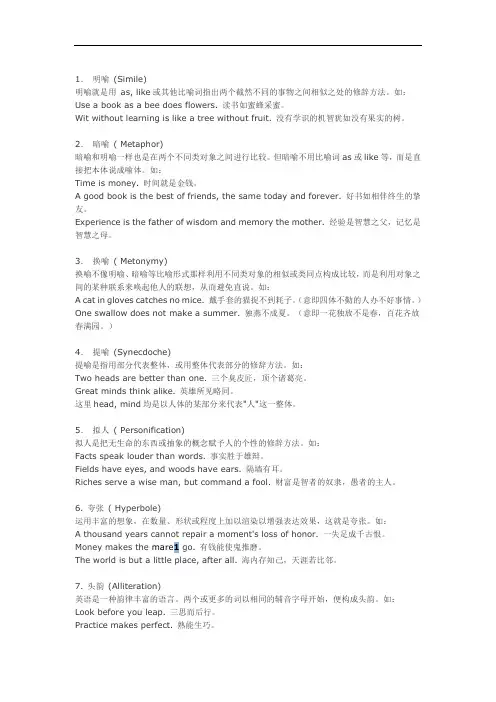
1.明喻(Simile)明喻就是用as, like或其他比喻词指出两个截然不同的事物之间相似之处的修辞方法。
如:Use a book as a bee does flowers. 读书如蜜蜂采蜜。
Wit without learning is like a tree without fruit. 没有学识的机智犹如没有果实的树。
2.暗喻( Metaphor)暗喻和明喻一样也是在两个不同类对象之间进行比较。
但暗喻不用比喻词as或like等,而是直接把本体说成喻体。
如:Time is money. 时间就是金钱。
A good book is the best of friends, the same today and forever. 好书如相伴终生的挚友。
Experience is the father of wisdom and memory the mother. 经验是智慧之父,记忆是智慧之母。
3.换喻( Metonymy)换喻不像明喻、暗喻等比喻形式那样利用不同类对象的相似或类同点构成比较,而是利用对象之间的某种联系来唤起他人的联想,从而避免直说。
如:A cat in gloves catches no mice. 戴手套的猫捉不到耗子。
(意即四体不勤的人办不好事情。
)One swallow does not make a summer. 独燕不成夏。
(意即一花独放不是春,百花齐放春满园。
)4.提喻(Synecdoche)提喻是指用部分代表整体,或用整体代表部分的修辞方法。
如:Two heads are better than one. 三个臭皮匠,顶个诸葛亮。
Great minds think alike. 英雄所见略同。
这里head, mind均是以人体的某部分来代表"人"这一整体。
5.拟人( Personification)拟人是把无生命的东西或抽象的概念赋予人的个性的修辞方法。
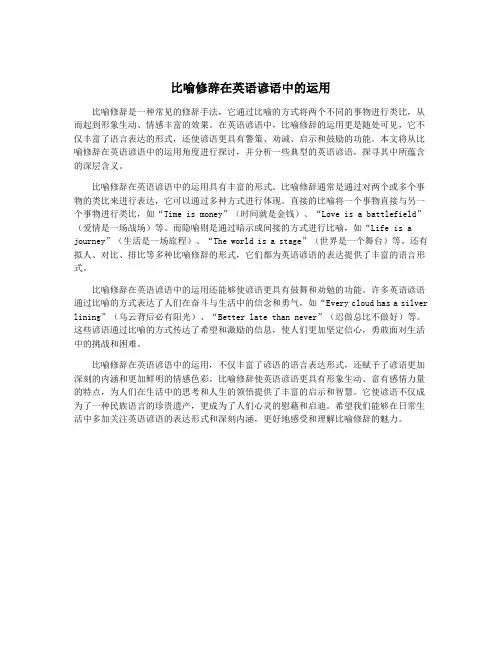
比喻修辞在英语谚语中的运用比喻修辞是一种常见的修辞手法,它通过比喻的方式将两个不同的事物进行类比,从而起到形象生动、情感丰富的效果。
在英语谚语中,比喻修辞的运用更是随处可见,它不仅丰富了语言表达的形式,还使谚语更具有警策、劝诫、启示和鼓励的功能。
本文将从比喻修辞在英语谚语中的运用角度进行探讨,并分析一些典型的英语谚语,探寻其中所蕴含的深层含义。
比喻修辞在英语谚语中的运用具有丰富的形式。
比喻修辞通常是通过对两个或多个事物的类比来进行表达,它可以通过多种方式进行体现。
直接的比喻将一个事物直接与另一个事物进行类比,如“Time is money”(时间就是金钱)、“Love is a battlefield”(爱情是一场战场)等。
而隐喻则是通过暗示或间接的方式进行比喻,如“Life is a journey”(生活是一场旅程)、“The world is a stage”(世界是一个舞台)等。
还有拟人、对比、排比等多种比喻修辞的形式,它们都为英语谚语的表达提供了丰富的语言形式。
比喻修辞在英语谚语中的运用还能够使谚语更具有鼓舞和劝勉的功能。
许多英语谚语通过比喻的方式表达了人们在奋斗与生活中的信念和勇气,如“Every cloud has a silver lining”(乌云背后必有阳光)、“Better late than never”(迟做总比不做好)等。
这些谚语通过比喻的方式传达了希望和激励的信息,使人们更加坚定信心,勇敢面对生活中的挑战和困难。
比喻修辞在英语谚语中的运用,不仅丰富了谚语的语言表达形式,还赋予了谚语更加深刻的内涵和更加鲜明的情感色彩。
比喻修辞使英语谚语更具有形象生动、富有感情力量的特点,为人们在生活中的思考和人生的领悟提供了丰富的启示和智慧。
它使谚语不仅成为了一种民族语言的珍贵遗产,更成为了人们心灵的慰藉和启迪。
希望我们能够在日常生活中多加关注英语谚语的表达形式和深刻内涵,更好地感受和理解比喻修辞的魅力。
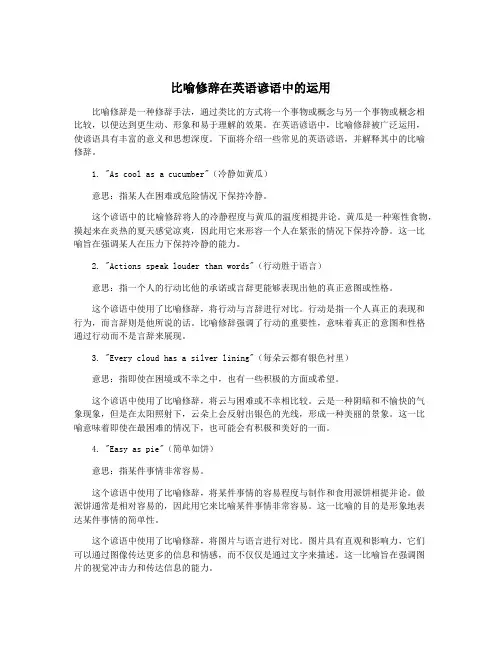
比喻修辞在英语谚语中的运用比喻修辞是一种修辞手法,通过类比的方式将一个事物或概念与另一个事物或概念相比较,以便达到更生动、形象和易于理解的效果。
在英语谚语中,比喻修辞被广泛运用,使谚语具有丰富的意义和思想深度。
下面将介绍一些常见的英语谚语,并解释其中的比喻修辞。
1. "As cool as a cucumber"(冷静如黄瓜)意思:指某人在困难或危险情况下保持冷静。
这个谚语中的比喻修辞将人的冷静程度与黄瓜的温度相提并论。
黄瓜是一种寒性食物,摸起来在炎热的夏天感觉凉爽,因此用它来形容一个人在紧张的情况下保持冷静。
这一比喻旨在强调某人在压力下保持冷静的能力。
2. "Actions speak louder than words"(行动胜于语言)意思:指一个人的行动比他的承诺或言辞更能够表现出他的真正意图或性格。
这个谚语中使用了比喻修辞,将行动与言辞进行对比。
行动是指一个人真正的表现和行为,而言辞则是他所说的话。
比喻修辞强调了行动的重要性,意味着真正的意图和性格通过行动而不是言辞来展现。
3. "Every cloud has a silver lining"(每朵云都有银色衬里)意思:指即使在困境或不幸之中,也有一些积极的方面或希望。
这个谚语中使用了比喻修辞,将云与困难或不幸相比较。
云是一种阴暗和不愉快的气象现象,但是在太阳照射下,云朵上会反射出银色的光线,形成一种美丽的景象。
这一比喻意味着即使在最困难的情况下,也可能会有积极和美好的一面。
4. "Easy as pie"(简单如饼)意思:指某件事情非常容易。
这个谚语中使用了比喻修辞,将某件事情的容易程度与制作和食用派饼相提并论。
做派饼通常是相对容易的,因此用它来比喻某件事情非常容易。
这一比喻的目的是形象地表达某件事情的简单性。
这个谚语中使用了比喻修辞,将图片与语言进行对比。
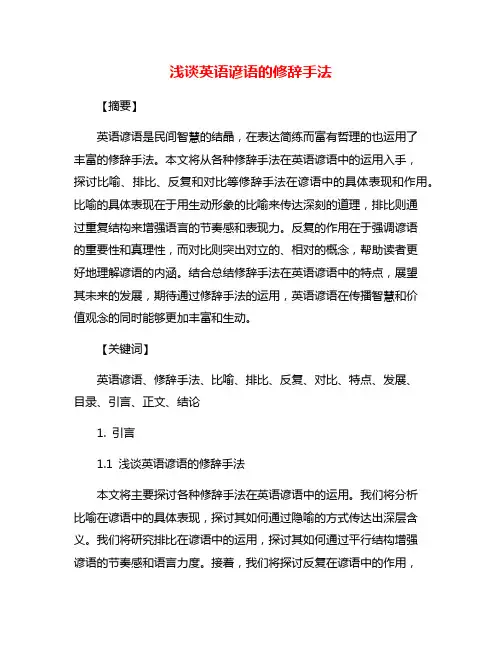
浅谈英语谚语的修辞手法【摘要】英语谚语是民间智慧的结晶,在表达简练而富有哲理的也运用了丰富的修辞手法。
本文将从各种修辞手法在英语谚语中的运用入手,探讨比喻、排比、反复和对比等修辞手法在谚语中的具体表现和作用。
比喻的具体表现在于用生动形象的比喻来传达深刻的道理,排比则通过重复结构来增强语言的节奏感和表现力。
反复的作用在于强调谚语的重要性和真理性,而对比则突出对立的、相对的概念,帮助读者更好地理解谚语的内涵。
结合总结修辞手法在英语谚语中的特点,展望其未来的发展,期待通过修辞手法的运用,英语谚语在传播智慧和价值观念的同时能够更加丰富和生动。
【关键词】英语谚语、修辞手法、比喻、排比、反复、对比、特点、发展、目录、引言、正文、结论1. 引言1.1 浅谈英语谚语的修辞手法本文将主要探讨各种修辞手法在英语谚语中的运用。
我们将分析比喻在谚语中的具体表现,探讨其如何通过隐喻的方式传达出深层含义。
我们将研究排比在谚语中的运用,探讨其如何通过平行结构增强谚语的节奏感和语言力度。
接着,我们将探讨反复在谚语中的作用,分析其如何通过反复强调某一含义或观点。
我们将探讨对比在谚语中的体现,分析其如何通过对比形成鲜明的对照效果。
通过对这些修辞手法的分析,我们可以更好地理解英语谚语的表达方式,并深入挖掘其中蕴含的丰富内涵。
同时也可以为我们今后的英语学习和交流增添更多的技巧和灵感。
将成为我们探讨的重要课题,希望能够给我们带来更多的启示和思考。
2. 正文2.1 各种修辞手法在英语谚语中的运用英语谚语是人们在日常交流中经常会用到的一种修辞表达方式,通过简洁而富有启发性的语言,传达出深刻的人生哲理和生活智慧。
在英语谚语中,各种修辞手法都得到了充分的运用,让谚语更富有表现力和吸引力。
我们可以看到英语谚语中经常运用的比喻手法。
比喻是一种通过将事物相互对应来进行说明的修辞手法,能够让抽象的概念更具体形象化。
比如谚语中的“Actions speak louder than words”就是通过比喻来强调行动比言论更有力量。
![[英语谚语的修辞特点与研究]英语谚语明喻修辞](https://uimg.taocdn.com/b76f1bc1bd64783e08122bb0.webp)
[英语谚语的修辞特点与研究]英语谚语明喻修辞谚语是民俗文化的结晶,是人类智慧的花朵。
英国作家培根(Francis Bacon 1561-1626)曾说过,“一个民族的天赋和智慧精神都是从他们的谚语中表现出来”(Genius, wit and spirit of a nation are discovered by their proverbs)。
英语谚语“A proverb is a short sentence based on long experience.”(谚语是长期经验的总结)说明了谚语的形式和渊源,谚语的产生首先是人民生活经验的凝结,然后才会碰撞出智慧的火花。
《麦克米伦谚语、格言和警句》的编者史蒂文森说:“表达普遍真理和行为准则的、具有句子形式的格言是谚语的幼虫期。
格言获得广泛接受,就像幼虫的翅膀丰满,变成谚语飞向世界各地。
”这段话形象地说明了谚语的形成过程。
当某个人在特定的环境中创造的惊人妙语,作为警句或格言使用时,由于它反映的是群体的经验和智慧,会得到广泛传播,而慢慢转化为谚语。
有人说“泉水最清,谚语最精”,这应该是用谚语给谚语下的最好的定义。
这句话也揭示出谚语的本质特点:语言精确简炼、鲜明生动。
谚语“Proverbs bea r age, he who would do well may view himself in them as in a looking glass.”(谚语世代相传,谁想干得美好,可把谚语当镜子照。
)这句谚语揭示了谚语的作用,谚语是生活的镜子,它能启迪人生,指导行为,使人们完善自我,获得美好的生活。
欣赏谚语之美的同时,译者和读者也要注意到,谚语翻译也会涉及到大量的语言学技巧,包含大量语言学特点。
然而,中英语言特点与其各自的语言社区相协调,仅仅限制在词面含义翻译时,谚语的表达功能将会减弱,甚至消失。
由此可以看出,谚语之所以能世代相传,不仅由于其承载智慧光芒的思想内容,而且由于其丰富多彩的艺术表现形式。
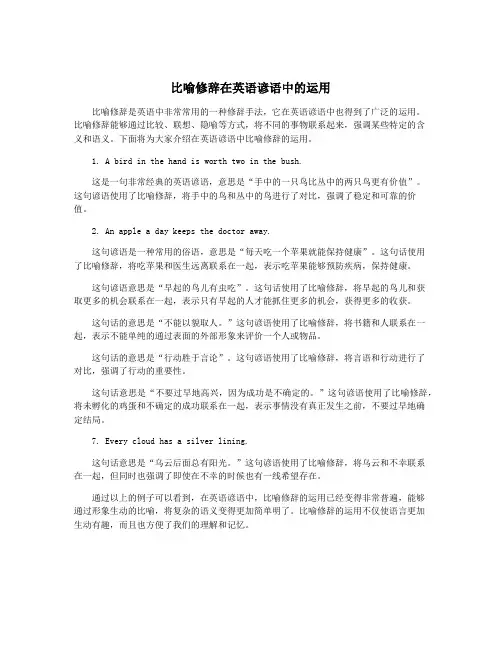
比喻修辞在英语谚语中的运用比喻修辞是英语中非常常用的一种修辞手法,它在英语谚语中也得到了广泛的运用。
比喻修辞能够通过比较、联想、隐喻等方式,将不同的事物联系起来,强调某些特定的含义和语义。
下面将为大家介绍在英语谚语中比喻修辞的运用。
1. A bird in the hand is worth two in the bush.这是一句非常经典的英语谚语,意思是“手中的一只鸟比丛中的两只鸟更有价值”。
这句谚语使用了比喻修辞,将手中的鸟和丛中的鸟进行了对比,强调了稳定和可靠的价值。
2. An apple a day keeps the doctor away.这句谚语是一种常用的俗语,意思是“每天吃一个苹果就能保持健康”。
这句话使用了比喻修辞,将吃苹果和医生远离联系在一起,表示吃苹果能够预防疾病,保持健康。
这句谚语意思是“早起的鸟儿有虫吃”。
这句话使用了比喻修辞,将早起的鸟儿和获取更多的机会联系在一起,表示只有早起的人才能抓住更多的机会,获得更多的收获。
这句话的意思是“不能以貌取人。
”这句谚语使用了比喻修辞,将书籍和人联系在一起,表示不能单纯的通过表面的外部形象来评价一个人或物品。
这句话的意思是“行动胜于言论”。
这句谚语使用了比喻修辞,将言语和行动进行了对比,强调了行动的重要性。
这句话意思是“不要过早地高兴,因为成功是不确定的。
”这句谚语使用了比喻修辞,将未孵化的鸡蛋和不确定的成功联系在一起,表示事情没有真正发生之前,不要过早地确定结局。
7. Every cloud has a silver lining.这句话意思是“乌云后面总有阳光。
”这句谚语使用了比喻修辞,将乌云和不幸联系在一起,但同时也强调了即使在不幸的时候也有一线希望存在。
通过以上的例子可以看到,在英语谚语中,比喻修辞的运用已经变得非常普遍,能够通过形象生动的比喻,将复杂的语义变得更加简单明了。
比喻修辞的运用不仅使语言更加生动有趣,而且也方便了我们的理解和记忆。
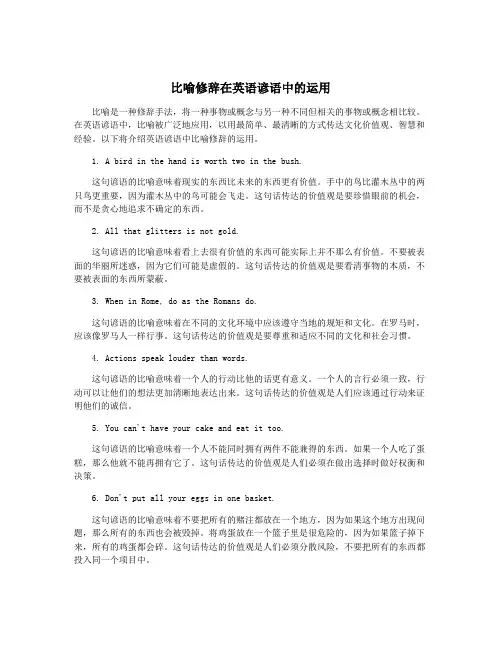
比喻修辞在英语谚语中的运用比喻是一种修辞手法,将一种事物或概念与另一种不同但相关的事物或概念相比较。
在英语谚语中,比喻被广泛地应用,以用最简单、最清晰的方式传达文化价值观、智慧和经验。
以下将介绍英语谚语中比喻修辞的运用。
1. A bird in the hand is worth two in the bush.这句谚语的比喻意味着现实的东西比未来的东西更有价值。
手中的鸟比灌木丛中的两只鸟更重要,因为灌木丛中的鸟可能会飞走。
这句话传达的价值观是要珍惜眼前的机会,而不是贪心地追求不确定的东西。
2. All that glitters is not gold.这句谚语的比喻意味着看上去很有价值的东西可能实际上并不那么有价值。
不要被表面的华丽所迷惑,因为它们可能是虚假的。
这句话传达的价值观是要看清事物的本质,不要被表面的东西所蒙蔽。
3. When in Rome, do as the Romans do.这句谚语的比喻意味着在不同的文化环境中应该遵守当地的规矩和文化。
在罗马时,应该像罗马人一样行事。
这句话传达的价值观是要尊重和适应不同的文化和社会习惯。
4. Actions speak louder than words.这句谚语的比喻意味着一个人的行动比他的话更有意义。
一个人的言行必须一致,行动可以让他们的想法更加清晰地表达出来。
这句话传达的价值观是人们应该通过行动来证明他们的诚信。
5. You can't have your cake and eat it too.这句谚语的比喻意味着一个人不能同时拥有两件不能兼得的东西。
如果一个人吃了蛋糕,那么他就不能再拥有它了。
这句话传达的价值观是人们必须在做出选择时做好权衡和决策。
6. Don't put all your eggs in one basket.这句谚语的比喻意味着不要把所有的赌注都放在一个地方,因为如果这个地方出现问题,那么所有的东西也会被毁掉。
英语谚语中的比喻修辞作者:汪洋来源:《文艺生活·文海艺苑》2016年第01期摘要:英语谚语采用大量的比喻修辞格,使之形象鲜明,富有艺术感染力。
本文结合实例就比喻中的明喻、暗喻、提喻修辞进行深入探讨。
关键词:英语谚语;比喻修辞格;明喻;暗喻;提喻中图分类号:H315 文献标识码:A 文章编号:1005-5312(2016)03-0077-01谚语是熟语的一种,是流传于民间的比较简练而且言简意赅的形式。
它是人们生活实践的总结,对人们的生活起着重要的作用。
英语谚语是英语语言的瑰宝,是民族智慧的结晶。
其中修辞格的广泛运用是其魅力的一个重要原因,比喻又是最常用的修辞手法。
因此,如果我们能理解这些修辞手法在谚语中引起的效果,那么我们也能更好的理解和应用这些谚语,从而更好的掌握英语的语言特点,提高英语语言运用能力。
一、英语谚语的比喻修辞法比喻是最常用的修辞手法之一。
比喻就是“打比方”,即两种不同性质的事物,彼此有相似点,便用一事物来比方另一事物的修辞。
运用比喻能把深奥的事物说的浅显易懂,能把抽象的事物说的说的通俗形象,便于接受。
常见的比喻手法可以分为:明喻、暗喻、提喻。
(一)明喻(Simile)明喻是最简单和基本的修辞。
它是将具有某种共同特征的两种不同事物连接起来的一种修辞手法。
明喻通常由三部分构成,即本体,喻体和比喻词。
其基本格式为“A is like B”或“A is as...as B”。
比喻词“like”即可以放在系动词之后也可以放在动词之后。
例如:A man without religion is like a horse without a bridle.(没有信仰的人就像没有缰绳的马); They agree like two cats in a gutter. (像沟里的两只猫一样情投意合).在上面的这些谚语中,“like”放在动词之后,此时动词agree的特征用我们所熟悉的猫比喻的生动形象。
比喻修辞在英语谚语中的运用比喻修辞是修辞手法中的一种,通过将一个事物与另一个具有共同特征或类似特征的事物相比较,来加强语言的表达效果。
在英语谚语中,比喻修辞的运用非常常见,可以让谚语更具形象生动,更富有文学性。
本文将就比喻修辞在英语谚语中的运用进行探讨。
谚语是人们在日常生活中总结出来的一些具有普遍真理的话语,而在这些谚语中,比喻修辞的运用可以使谚语更富有表现力。
比如常见的谚语“Time is money”,这句话的字面意思是时间就是金钱,在生活中也确实如此。
但是它通过将时间与金钱相比较,来强调时间的宝贵和重要,使得这个谚语更生动、更富有比喻修辞的特色。
比喻修辞可以使谚语更易于理解和记忆。
当我们用比喻的方式来表达一种概念时,往往更容易让人理解和记忆。
比如“Don't count your chickens before they hatch”(不要在鸡蛋未孵化之前数小鸡),这句谚语通过比喻的方式告诫人们不要在事情没有确定之前就过早乐观,不要过早得意忘形。
这种通过比喻修辞表达的真理,更容易让人们理解并且记牢。
比喻修辞还可以使谚语更具有鲜明的形象特点。
在英语谚语中,很多都通过比喻的方式来表达一些普世的真理,比如“All that glitters is not gold”(闪闪发光的不一定都是金子),这句谚语就是通过比喻的手法,用金子来比喻真理和财富,告诉人们并不是表面上看起来有价值的东西就是真正有价值的。
这种比喻修辞使谚语更加形象生动,并且更容易引起人们的共鸣。
比喻修辞也可以使谚语更具有文学性。
在英语谚语中,有许多都是通过比喻修辞的方式来表达一些普遍的真理和智慧。
比如“Bite off more than one can chew”(咬下了自己无法咀嚼的东西),这句谚语通过比喻的方式告诉人们不要贪得无厌,不要去做自己无法承受的事情。
比喻修辞赋予了这句谚语更多的意蕴和文学性,使得它不仅仅是一句简单的教训,更像是一种富有诗意的表达。
比喻修辞在英语谚语中的运用
比喻修辞是英语谚语中常见的修辞手法之一,它通过用一个形象、熟悉或具有感染力的比喻形象来描述一个事物或情境。
在英语谚语中,比喻修辞的运用可以更加生动地表达某个概念、想法或行为,起到增强表达和印象的作用。
下面给大家举几个例子进行解释:
1. "Actions speak louder than words."
这句话表示的是,行动比语言更能表达真实的想法和态度。
比喻修辞体现在用“声音更响亮”这一形象化的比喻来表述行动更能引人注意,印象更深刻。
这个谚语告诉我们,如果一个人经常不断地追求新的经验和机会,那么他就不会有时间停下来生根发芽,也就无法积累经验和知识。
比喻修辞体现在用“滚石不生苔”这一比喻来表达一个人无法积累经验的意思。
这句话告诉我们,生活的过程比目标的实现更重要。
比喻修辞在这里体现在把生活比喻成一次旅程,而不是目的地,这种比喻形象生动,易于理解。
4. "All the world's a stage, and all the men and women merely players."
这个莎士比亚名言把整个世界比喻成一个舞台,每个人都是演员。
比喻修辞体现在用“舞台”这一形象来表达全球是一个巨大的舞台,每个人都在上面扮演自己的角色。
这个谚语告诉我们,把金钱省下来和赚得到金钱是有同样的效果。
比喻修辞体现在用“节约”和“赚钱”这两个行动的比喻来表达他们的共同点。
浅析英语谚语中的修辞手法摘要:所谓英语谚语,类似于汉语谚语,它是英语国家民间流行的简短而又具备一定劝诫意义的语句,英语谚语读起来朗朗上口,而且描述生动,非常容易把握,因此,被广泛流传下来。
本文借鉴国内外对于英语谚语中的修辞手法的已有研究成果,并且通过生动的实例来继续对于英语谚语中的修辞手法进行探索。
关键词:英语谚语;修辞手法;拟人;典故;重复;首韵;讽喻一、引言翻阅英语谚语,我们不难发现绝大多数英语谚语通过修辞手法来实现了“包装”,在音、形两个层面上都独具特色,给人的一种非常美好的感觉。
通常情况下,英语谚语惯用拟人、典故、重复、首韵、讽喻等修辞手法。
接下来,本文将对于英语谚语中的这些修辞手法进行详细的阐述。
二、英语谚语中的拟人修辞手法英语谚语中的拟人修辞手法将人以外的无生命之物或有生命之物当作人来描写,并将其写得既有人的动作,又有人的思想感情,有时也将人比作动物或事物,因此,增加了生动感和表现力。
在英语谚语中的例子如下:(1)a cock is valiant on his own dunghill. 夜郎自大。
(2)straws show which way the wind blows.草动知风向。
通过英语谚语中的拟人修辞手法的运用,赋予某些词语不同于本义的新义,使其语言生动、形象,更具有感染力,给读者与读者留下深刻的印象。
三、英语谚语中的典故修辞手法所谓英语谚语中的典故修辞手法就是指,许多英语谚语是来自于一个历史事件或者名言的。
在英语谚语中,许多谚语来来源于古典文学作品,更准确地说,有如下几种来源:希腊神话、圣经、伊索寓言以及文学巨匠的作品。
英语国家的许多谚语都最早记录在这些古典文学作品当中,对于英语国家的文化有着深刻的影响,能够体现出典故英语谚语的丰富内涵和语言风格,同时,应该引起注意的是,这些来自英语典故的谚语的汉语翻译既要能较完整地表达其在原典故中的寓意,又要能为广大的中国读者所接受。
比喻修辞在英语谚语中的运用比喻是修辞手法的一种,是一种通过利用形象、生动的比较来传达思想和情感的表达方式。
在英语的谚语中,比喻修辞被广泛运用,给人留下深刻印象,使谚语更加生动、有趣,同时也更加容易被人们所理解和记忆。
下面将通过一些经典的英语谚语来解释比喻修辞在谚语中的运用。
1. "A watched pot never boils."(瞪着壶盖水也不会开。
)这句谚语以“瞪着壶盖”来比喻盯着某件事情,表达的意思是过于焦急地盼望某件事情发生反而会让事情变得更加缓慢。
这里的“瞪着壶盖”就是比喻焦急地等待某件事情就像盯着壶盖期待水烧开一样。
这句谚语用“豹子”和“斑点”来比喻人的性格和本性。
意思是一个人的性格和习惯是不容易改变的,就像豹子的斑点一样固定不变。
这句谚语用“厨师”和“汤”来比喻人数过多导致事情变得混乱和不顺畅。
意思是过多的人参与到某件事情中会导致效率降低,结果变得更糟糕。
4. "A bird in the hand is worth two in the bush."(一鸟在手胜似二鸟在林。
)这句谚语用“一鸟”和“两鸟”来比喻眼前的利益和未来的可能。
意思是眼前的利益比未来的可能要更加稳妥和有价值。
5. "Don't count your chickens before they hatch."(鸡蛋未孵出之前别数鸡。
)这句谚语用“鸡蛋”和“孵出”来比喻事情的成功和结果。
意思是在事情未成功之前不要过早地乐观。
在英语谚语中,比喻修辞的运用既丰富又深刻,让人们能够更好地理解一些抽象的观念和道理。
在“Too many cooks spoil the broth.” 这句谚语中,通过比喻的方式生动地表达了过多的人参与实际上会造成事情的混乱,更加容易让人们理解和接受。
再“Don't count your chickens before they hatch.” 这句谚语警示人们不要过早地乐观,因为事情的结果往往是不确定的,通过比喻使这句谚语更加生动有趣,更加容易被人们所接受。
比喻修辞在英语谚语中的运用比喻修辞是修辞手法中的一种,通过对两种不同的事物进行相互类比来表达某种含义或者概念。
在英语谚语中,比喻修辞被广泛运用,通过对各种事物的比喻来传达智慧或者道理。
本文将探讨比喻修辞在英语谚语中的运用,并通过谚语的实例来说明这一修辞手法的精妙之处。
比喻修辞在英语谚语中的运用可以说是非常常见的。
谚语是人们在长期的生活体验中总结出来的智慧和经验的结晶,通过简洁、生动的表达方式来传递理念或者道德规范。
比喻修辞的使用使得这些谚语更具有生动性和形象性,更容易被人们理解和记忆。
"A bad workman always blames his tools."这是一个经典谚语,意思是一个不会做事的人总是会找借口责怪工具或者环境。
这个谚语通过比喻修辞将"不会做事的人"和"找借口责怪工具"进行了类比,使得这句谚语更加生动、形象。
另一个例子是"Actions speak louder than words."这句谚语通过比喻修辞将"行动"和"言语"进行了类比,表达出了行动比言语更有力量的含义。
这句谚语的形象性和生动性使得其更容易被人们理解和接受。
在英语谚语中,比喻修辞往往通过对自然界的事物进行类比来传递智慧。
"A bird in the hand is worth two in the bush."这句谚语通过对抓在手里的鸟和丛中的两只鸟进行了类比,表达了稳妥和谨慎的道理。
通过这种生动的比喻修辞,这句谚语更容易被人们理解和接受。
比喻修辞在英语谚语中的运用不仅使谚语更加生动形象,也使得谚语更具有启发性和哲理性。
通过对两种不同事物之间的类比,谚语传达出的道理更容易被人们领会和接受。
所以比喻修辞在英语谚语中的运用是至关重要的,它丰富了谚语的表达形式,使得谚语更容易为人们所理解和接受。
辅修专业学士学位毕业论文(设计)题目(中文):英语谚语中的比喻修辞(英文):The Tropes in English Proverbs学院年级专业学生姓名学号指导教师完成日期年月The Tropes in English ProverbsWritten bySupervised byA Thesis Submitted toShanghai Normal UniversityIn Partial Fulfillment of the Requirements forThe Degree of Bachelor of ArtsForeign Languages College, Shanghai Normal UniversityDecember 2011AcknowledgmentsI want to acknowledge the invaluable help of Ms. Shen, my constant consultant, who has made timely and useful suggestions on working out the outline, refining the earlier drafts and given me enlightening advice throughout the whole process of writing the thesis. I especially appreciate her guidance and wish to extend my sincere gratitude to her.This work also owes much to my dear friends whose encouragement and great help inspires me to make further efforts when I encounter difficulties and was sometimes at loss.My heart-felt thanks are also due to my father and mother, who have been in constant favor of me and offered me the best they could.This thesis would not have been possible without the support and assistance that I received from them. My grateful thanks go to you all.AbstractPeople all know English proverbs are charming. Proverbs are widespread. They are simple but meaningful. They are vivid and humour, which they are the typical examples of aesthetic rhetoric and represents treasure of English language. They are the wisdom of English people. Using rhetoric is an important reason why the English proverbs are charming. Among them, the tropes are the most common rhetoric. Therefore, I analyze the tropes in English proverbs in this paper. Tropes can be divided into simile, metaphor, analogy, allegory, metonymy and synecdoche. This article focuses on simile, metaphor and synecdoche.This paper is divided into four chapters. They are introduction, literature review, analysis and conclusion. The first chapter introduces the tropes of English proverbs. The second chapter makes a simple introduction about the importance of the tropes in English proverbs. Then this paper makes a brief analysis of the simile, metaphor and synecdoche in English proverbs. It includes their definition, structure and semantic effect. The article lists lots of examples to explain them. Sometimes they are explained in Chinese to make readers understand easily. The final chapter concludes the thesis.This article helps us understand the meaning of the tropes in English proverb. If we can understand the semantic effect in English proverbs, we can comprehend and use these English proverbs better than before.Key words: English proverbs; tropes; simile; metaphor; synecdoche摘要英语谚语具有永恒的魅力,英语谚语内容十分广泛,且具有言少意多、言浅意深、生动形象、幽默风趣、观点鲜明等特点,是美学修辞的典范,是英语语言的瑰宝,是英语民族智慧的结晶。
其中修辞格的广泛运用是其魅力的一个重要原因,比喻又是最常用的修辞手法。
因此在本文中,我详细介绍了英语谚语中比喻修辞的手法并分析。
比喻可分为明喻、暗喻、借喻、讽喻、换喻和提喻。
本文主要就比喻中的明喻、暗喻、提喻修辞进行深入探讨。
本文共分四章。
其中第一章对英语谚语的修辞手法做了简单介绍。
第二章介绍了英语谚语以及修辞的背景。
第三章分别对明喻、暗喻、提喻进行分析,包括他们的定义,结构以及引起的语义效果。
文中列举了大量例子来佐证这几种比喻手法,并进行了详细的分析,并在其中穿插了中文解释,帮助我们更容易理解这些谚语的意义。
最后,总结全文,这篇文章帮助我们理解了英语谚语中比喻修辞手法的涵义,如果我们能理解这些修辞手法在谚语中引起的效果,那么我们也能更好的理解和应用这些谚语。
关键词:英语谚语;比喻修辞格;明喻;暗喻;提喻ContentsAcknowledgments (i)Abstract ..................................................................... (ii)摘要 (iii)1. Introduction (1)2. Literature review (2)3. Simile (2)3.1 The definition of simile (3)3.2 The basic format of simile (3)3.2.1 "As" style (3)3.2.2 "Like" style (4)3.2.3 "What" style (5)3.2.4"And" style (5)3.3 The semantic effect of simile (5)4.Metaphor (7)4.1 The definition of metaphor (7)4.2 The basic format of metaphor (8)4.2.1Conceptual metaphor (8)4.2.2 Coalescent metaphor (8)4.2.3 Implicative metaphor (9)4.2.4 Symbolic metaphor (10)4.3 The semantic effect of metaphor (10)5. Synecdoche (11)5.1 The definition of synecdoche (11)5.2 The basic format of synecdoche (11)5.3 The semantic effect of synecdoche (12)6. Conclusion (13)Bibliography (15)1. IntroductionWith regards to the ever lasting charm of the English proverbs, there are various reasons, the most important of which is the extensive use of English rhetorical devices. The rhetorical background of the English proverbs concerns their sources and the tradition of western rhetorics. The purpose of the use of rhetoric such as antithesis, repetition, rhyme and analogy is to make the proverb spread widely.English proverb is a valuable property in British folklore. It embodies the people's experience of life and struggle, which is the most vivid, harmonious and profound but simple and popular sentence. It is accumulated by hundreds of people from generation to generation.English proverbs are created by working people. It uses short, pithy linguistic forms to express. It often uses tropes, metonymy and contrast to describe the understanding of the laws of nature. English proverbs are the summary of social practice. Therefore, English proverbs are concrete and vivid.The use of rhetoric is essential in English writing. With the rhetoric, we can express our thoughts and emotions better. English proverb is a stationary statement that widespread among the masses of people. It plays an important role in language. At the same time, the vocabulary of English proverb is often easy to understand but meaningful.In essence, most of the English proverbs contain tropes, which makes proverbs more specific, concise and euphemism. Generally speaking, the application of tropes in English proverbs can make people understand and remember them more easily.Tropes include metaphor, simile, synecdoche, allegory, metonymy, allegory etc. In some areas, the study of rhetorical is a complex and interesting subject. In this limited space, I would only discuss the applications of three kinds of tropes.2.Literature reviewEnglish proverbs come from the practice and they reflect the practice. They are charming and full of philosophy. They are popular with people and pass down generation by generation. Then why are English proverbs so charming? There are various kinds of reasons. The main reason I think is the extensive use of the rhetoric. Those simple words can tell the reader a complicated principle. That is the benefit of the use of rhetoric.According to the modern view of rhetoric, it aimed at improving the semantic effect. Rhetoric is divided into two parts. They are communicative rhetoric and aesthetic rhetoric. In communication rhetoric, we put the emphasis on the clear content, fluent sentence and strict structure. But in aesthetic rhetoric, we often pay attention to its aesthetics. In aesthetic rhetoric, we can imagine the situation in our mind through its attractive words.Proverb is a language form that all kinds of the language have. They are used almost everywhere. At the same time, proverb is a typical example of aesthetic rhetoric. It is a treasure of the English language. It is the wisdom of the English people. Because of the extensive using of rhetorical in English proverb, it is simple but vivid, pithy but meaningful. We can find many rhetorics in English proverbs. They show the beauty of the English proverbs.On the other hand, trope is the most important and common rhetoric. It is an important part in rhetoric. It is an outstanding symbol in English proverbs. In other words, no tropes, no proverbs.3.SimileSimile is the simplest and basic rhetoric. In order to depict the image of a person or something clearly, people often compare something or someone who has the same characteristics with other person or things.3.1 The definition of simileA Dictionary of Literary Terms defined simile as:"A figure of speech in which one thing is likened to another.In such a way as to clarify and enhance an image.It is explicit comparison (as opposed to the metaphor where comparison is implicit) recognizable by the use of words 'like' or 'as' "(Craige 2002:36). The word "like" and "as" are called "introductory word" of the simile. The format of simile is "the signified + the introductory word + the signifier". Word like, as, as if, as though, as...as, as...so, similar to, to bear a re-semblance to are common introductory word.The definition of simile in the Word Net English-English dictionary is a figure of speech that expresses a resemblance between things of different kinds (usually formed with `like' or `as').According to this authority and broad definition of simile, it is a rhetoric which manifest one thing like the other thing. In a common way, the signified has the same characteristics with the signifier. There are lots of common introductory words like as, seem, as if, as though, such as and so on. The basic format of simile is "A is like B" or "A is as ... as B". It also has other forms: virtual style, "that" style, "than" style, the verb style and "and" style. Simile is usually used in advertisement and technology description text because it shows the similar between one thing and the other thing. Reader can understand the description of the object and spirit easily. Among them, the signified is the object to be described, while the signifier is the object which is familiar to people.3.2 The basic format of simile3.2.1 "As" styleThere are two forms. One is the word "as"which is placed after the word "be" to act as predicative. Such as: An honest man's word is as good as his bond.(诚实人的诺言, 如同他立下的契约一样可靠). Another is the word "as" which is placed after the action verb to act as adverbial. For example: Children pick up words as pigeon peas, and utter them as God shall please (小孩学舌如鹦鹉, 再次说出无口误), He bides as fast as a cat bound to a saucer (守候得牢靠就像守候食碟的猫). Sentence whichis guided with the word "as" is relatively rare in English proverbs. However, phrases which are guided with word "as" can be found everywhere. Such as: as busy as a bee, as deep as the sea, as fine as sand, as gentle as a breeze, as healthy as an ox, as hungry as a wolf , as light as a cloud, as pure as spring water, as regular as the clock, as white as snow, as wild as a tiger.As we can see from these examples, in these phrases, the word "as" is followed by adjective which describe the characteristics of something to guide the simile.3.2.2 "Like" styleSimile guided by the word "like" can either be placed after the copula or after the action verb. When it comes to the sentence, it is placed after action verbs to serve as predicative. For example: Living without an aim is like sailing without a compass.(无目标的生活,就象无罗盘的航行);A man without religion is like a horse without a bridle.(没有信仰的人就像没有缰绳的马);A man of words and not of deeds is like a garden full of weeds. (只说不做的人,犹如光长野草的花园).A face without a smile is like a lantern without a light (没有笑容的脸蛋犹如没有亮光的灯笼);A broken heart is like broken china: we can mend it , but we can never erase the scars(破碎的心好比破碎的瓷器: 我们可以修补它, 但永远也不可能消除其伤痕);and so on.In the saying, only a few simile which is guided by the word "like" is placed after action verb to act as adverbial modifier. Such as: A merry heart does good like a medicine (保持快乐的心情就像药物一样有益); They agree like two cats in a gutter. (像沟里的两只猫一样情投意合).On the other hand, English is replete with phrases including words "like". Such as: to drink like a fish, to eat like a horse, to fly like a bird, to shine like gold, to sing like a lark, to sleep like a log, to swim like a duck, to twinkle like a star, to work like a horse and so on.In these phrases, the simile guided by the word "like" is placed after action verb to serve as adverbial modifiers. At this time, the characteristic of the verb is described vividly by using something we are familiar with.3.2.3 "What" styleThere are two common styles: A is to B what C is to D and What C is to D, A is to B. For example: Reading is to the mind, what exercise is to the body(读书对身心之重,恰如运动之于身体). Intellect is to the mind what sight is to the body (智力对思想犹如视力对于身体一样重要).The word "what" also can be put at the beginning of the sentence instead of the end of sentence. They are usually used to tell the importance between two things. For example: What the blue print is to the builder, the outline is to the writer (提纲对于作家犹如蓝图对于建筑师一样重要). What salt is to food, that wit and humor are to conversation and literature (妙语与幽默之于会话与文学,恰似盐对于食物一样).The above two examples is the second style. The word "that" connects main clause and subordinate clause. But usually word "that"can be omitted.3.2.4 "And" styleIt is a special kind of simile structure, which is common in English proverbs. This particular simile compares two collocation elements which are before and after the word "and". But word "and" in this situation can not be understood as "together", it means "like" here. For example: Love and cough cannot be hid. It means Love is like cough that they could not be escaped from the eyes and ears. In Chinese, it means 恋爱如同咳嗽,难逃人耳目. For another example: Truth and rose have thorns about them.(真理象玫瑰那样多刺). Books and friends should be few but good.(读书如交友,应求少而精)3.3 The semantic effect of simileAll in all, the object's shapes, movements and states can be described vividly in a clear way by using simile.The introductory word in the simile likes a bridge, which links the signified and the signifier closely. People can imagine two things through the introductory words.For example: Ill-gotten wealth is like a palace built on the sand.In this sentence, "ill-gotten wealth" is the signified, while "a palace built on the sand" is the signifier. The two things were connected with each other with the word "like" so that people associated the "ill-gotten wealth" with "the palace build on the sand" which is familiar to people. The proverb warns people that we must make money through hard work, or we will worry everyday when we use them. Also it warns that we cannot make money by foul means even though we face difficulties. The proverb Chinese meaning is 财富来得不正当,犹如宫殿建沙上.People may know:Beauty, unaccompanied by virtue, is as a flower without perfume.Beauty is a forever topic, we can say that everybody loves beauty. However, how can we understand the beauty correctly? How can we treat the beauty in and out correctly? We must put the emphasis not only on the appearance but also on their virtue. This proverb shows "beauty, unaccompanied by virtue" as "a flower without perfume". It illustrates such a philosophy: People always praise the beauty. But they praise not only for the pretty appearance but also for pretty heart. Proverbs also touched a deeper problems that lots of people aspire to the outer so that they ignore the external things in real life. In essence, beauty is pure but skin-deep and short lived. Only the beauty with inner virtue is forever.Another example: Reading is to the mind, what exercise is to the body.The main features of this kind of structure is its direct meaning, clear and symmetrical structure, antithesis neat and beautiful sentence patterns. This style of simile is often used to reveal the deeper or abstract meaning so that people can be impressed by these deep significance. What the proverb want to tell us is the importance of reading to the mind. Now it is expressed by the simple and obvious relationship between the body and exercise. It makes people understand easily.Enough is as good as feast.Living in this society, we have lots of demands for material and spirit. Proper desire can encourage one to make bigger progress, but endless desire often can ruin him. Proverb uses the structure that "as +adjective +as" to link the "enough"and "feast" to illustrate the meaning that true happiness is in a contented mind.4. MetaphorMetaphor is one kind of the tropes. According to the common features between two things, the reader must understand the meaning by himself instead of getting it directly. There are many examples in English proverbs.4.1 The definition of metaphorMetaphor means "a comparison made between two things that are alike in certain aspect, but it is suggested rather than explicitly stated without using the word 'like' or 'as' "(吕雯2006: 132)We may summarize the definitions of metaphor as following: "in the Webster's version, metaphor is seen as a figure of speech; secondly, metaphor is the substitution of one word by another; thirdly, metaphor involves similarity between objects or concepts; finally, metaphor is regarded as a special case of simile"(陈明2003: 5).Metaphor, is an implicit comparison. It is different from the simile. There is no introductory word between the signified and the signifier. The structure of the metaphor is "the signified is the the signifier".Metaphor illustrates the objects more vividly and deeply than the simile. Its expression is more strong than the simile. Metaphors often do not use the introductory word. Usually it implies more meaning than the simile and it describe the image more obviously.When two things have the similar characteristics, we often use the word "is" to link the two things with each other, that is "A is B". The relationship between the signified and the signifier is direct and close. It is common in English proverbs.Because of the omission of the introductory word, the proverb become more brief.Metaphor has been divided into four forms. They are conceptual metaphor(概念隐喻), coalescent metaphor(结合型隐喻), implicative metaphor(含蓄型隐喻) and symbolic metaphor(象征隐喻). The use of metaphor makes English proverb vivid.4.2 The basic format of metaphor4.2.1 Conceptual metaphorAccording to the theory of cognitive linguistics, conceptual metaphor involves two parts. It has a function which is to understand one concept through the other concept. This metaphor can be applied to the formula that X (Noun A) is Y (noun B). So the conceptual metaphor has another name which is called equational metaphor. For example, in the phrase"Love is fire", "fire" is obviously used to compare to the "love". As we all know, love is high emotional intensity. The more intense the emotion is, the stronger the feeling of love is. So using the fire to describe the love is vivid and proper. Fire can be lightened, can exist and also can be crushed out. When the fire was lit, the love started. When the fire was burning, the love is existing. When the fire was extinguished, the love finished.In the proverb "Love is meat and drink", one of the two concepts is "love", and the other is "eat and drink." Here "eat and drink" means nutrition. People cannot live without eating or drinking. To put it another way, it means people cannot live without nutrition. Nutrition is essential to people. Similarly, life is not perfect without love. Love is essential to people, too. Food and drink brings us the physical nutrition so as the love brings us mental nutrition.There are many English proverbs including conceptual metaphor, such as: Life is a journey; The eyes are the window of the soul and so on.In some conceptual metaphors, the two conceptual words can be added one or two modifiers. Such as: A heart without love is a violin without strings, A beautiful face is a silent commendation, A cheerful heart is good medicine etc.4.2.2 Coalescent metaphorSome scholars believe that metaphor is a language phenomenon with two different types of words in one sentence. In other words, the coalescent metaphor is the combination of a general word and a metaphorical word. For example, in proverb "Every dog has his day", "dog" is the general word while "day" is a metaphoricalword which means joy. Similarly, in "Every cloud has a silver lining", "cloud" is the general word and "silver lining" is a metaphorical phrase which means a thread of hope. According to the structuralist, this type of sentence is called part-sentence metaphor.For example, the proverb "Laws catches flies but let hornets go free". "Flies" refers to the common people and "hornets" means VIP. Another example is "The apple never falls far from the tree". "the apple" refers to the children and "the tree" refers to their parents. The meaning of the sentence is: The characteristics of children are pretty similar to their parents.We can see from the above examples that no matter in conceptual metaphor or in part-sentence metaphor, the word or phrase refers to a designated and specific person or object.4.2.3 Implicative metaphorSome proverbs don't imply something by a word or phrase but refer to the meaning by all the sentence. For example, in "A net with a hole in it won't catch any fish", there is no word can imply a specific thing because the whole sentence is a metaphor. The meaning is: A plan with flaws can not be carried out perfectly. Another example, we cannot cut the proverb "Look before you leap" off because it is a whole. Its meaning is: You should consider the consequence of your action before you act. According to the theory of structural linguistics, this metaphor belongs to the whole-sentence metaphor.The people or the object is not specific but has different meanings in different situations in implicative metaphor. For instance, "Big thunder, little rain" can define one person who said much but did little under certain circumstances. It also can be equated with "Barking dogs seldom bite" under some circumstances. The meaning is "A man speaks much does not necessarily produce trouble to other people". For another example, in "The early bird catches the worm". "The early bird" can be pointed to different people in different situations: like the first interviewer, the inventor in some aspect, the earliest promoters of the industry and so on.4.2.4 Symbolic metaphorUsing one thing to represent another thing, using material things to represent the immaterial things and using specific things to represent abstract things is the symbolic metaphor. For example, "strike while the iron is hot" is symbolic metaphor. It uses the specific things to represent abstract things. It implies that we cannot miss any chance at any circumstance as long as the conditions are advantageous to us.Also, the proverb "Water dropping day by day wears the hardest rock away" is symbolic metaphor. It tell us the truth that we can be successful as long as we work hard at anytime anywhere. Another example is: "A bird may be known by its song". The "song" represents "the speech of a person". In "No cross, no crown", the "cross" refers to "suffer" and "crown" refers to "supreme". The proverb "A bird in the hand is worth two in the bush" means: The higher-value is too far away from us to get them, so we must cherish the thing we have, even it is small and cheap.4.3 The semantic effect of metaphorThere is an example, Some books are to be tasted, others to be swallowed, and some few to be chewed.In this proverb, the signifier does not appear, but its meaning is showed by the verb "taste", "swallow" and "chew" indirectly. In the proverb, books has been said as delicious. One kind of book is for human to taste, the other kind is for people to gobble, and the third is for people to read, to enjoy and remember. We can see the meaning of the this proverb easily because of its vivid vocabulary.English proverbs often use some materials or animals to refer to some kind of people. Sometimes the signified and the signifier are omitted in proverbs. Sometimes the signified and the signifier are replaced by the materials or animals.For example: A rolling stone gathers no moss.This proverb refers to a person who frequently changes his occupations can't save money. But in this proverb, they are replaced by the phrase "a rolling stone"and"moss". People can understand the truth that one must consider more before he change his career.In addition, there are many proverbs refer to people by animal words. "He that lies down with dogs, must rise up with fleas" is one of the examples. In this proverb, the "unworthy fellows" is replaced by the "dogs". In American, although the dogs have a reputation of men's best companion, people think if someone lives with them, he may easily get diseases. In Chinese, it means "近朱者赤, 近墨者黑".5. SynecdocheAccording to the English-English dictionary, synecdoche means substituting a more inclusive term by a less inclusive one or vice versa. It is a rhetoric that use part to replace the whole or use the whole to replace the part.5.1 The definition of synecdocheSynecdoche also belongs to the trope. For example, many hands make light work. Many hands make quick work.Two heads are better than one. Great minds think alike. In these proverbs words "hands", 'heads' and "minds" refer to people. This type of rhetoric is called synecdoche. We must pay attention to the difference between the translation of these proverbs in English and in Chinese. When we translate them, we must pay attention to the target language and source language. We must translate them properly so as to make readers understand and accept them.As we all know, if these proverbs do not use synecdoche, then the whole sentence will be very boring, pale and weak, the language will be very long and complicated.5.2 The basic format of synecdocheIn the proverbs, a part of the body is usually used to replace the person. It is a common phenomenon in English proverbs. For instance, in "Blood is thicker than water", the word "blood" refers to "the relations by descent from a common ancestor".In "No ear is so deaf as one which wishes not to hear", the word "ears" refers to "person or man". In "A fair face cannot have a crabbed heart", the phrase "a fair face" refers to "a beautiful person". In "The gray hair should be respected", it use "the gray hair" to replace "the old people". In "The breasts are better at the other side of the fence", the word "breast" means "wife". In the "Faint heart never won fair lady", the "faint heart" is used to refer to "a faint hearted man". In "A false tongue will hardly speak the truth", the real meaning of the phrase "a false tongue" is "a person with a false tongue". When we translate these sentences, we must pay attention to the real meaning of these words.As the part can replace the whole, the whole can replace the part. For example: The hand that rocks the cradle rules the world. In this proverb, the word "world" refers to "family". It belongs to this structure. This proverb means that mother is the leader of family.5.3 The semantic effect of synecdocheIn English proverbs, the use of synecdoche is not uncommon. For example: Two heads are better than one. In this proverb, word "heads" refers to "persons". This proverb belongs to the style of "part replace the whole". As the "head" is one part of the body, it is usually used to refer to an individual in English. For example, we count people by heads. In addition, the English often use the body's organs to refer to a person. Such as the word "hand", "heart", "mind", "mouth" (here means population) are used to refer to "man". People can always associate the whole with the part. They can recognize the whole through observation of the part. For example: Many hands make light work. Faint heart never won fair lady. Great minds think alike.In English proverbs, the abstract meaning is always expressed by specific things. It is very common in English proverbs. Its original idea is simple but its significance is deep.For example: He who would search for pearls must dive below.The proverb illustrates the relationship between "search for pearls" and "dive". In this sentence, the。